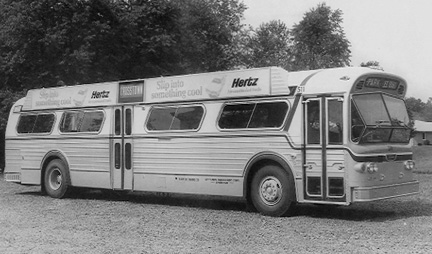Flxible-Flyers
501 through 506 were Park-and-Ride, having air-conditioning, soft seats, and an ungoverned three-speed automatic tranny.
570 through 576 (577?) were also Park-and-Rides, but two-speed (like our city-buses) and not air-conditioned. What made them Park-and-Rides were soft seats and the shotgun-seat faced the windshield, instead of the aisle.
All the rest of the 500s (507-569) were city-buses: two-speed automatic tranny governed to 56 mph.
The first 25 or so Flxibles had “batwings;” the lighted side-display advertising signs on the 500 (511) in the picture.
 |
| Regional Transit #511 with batwings. |
It had four valves in the head surrounding the injector, and they were exhaust.
Intake-air was blown into the cylinders by a large mechanical Rootes supercharger, converted for use on fuel-dragsters.
The blower pressurized the cylinder-sides, and blew intake-air into the cylinders through slots in the cylinder-sides uncovered when the piston reached the bottom of its stroke.
This action also blew exhaust out the top.
Electromotive (EMD) locomotive diesels followed the same principles at first: e.g. the 567, the 645, and now the 710. (That number signifies the individual cylinder displacement, as a 6-71 bus engine displaces 71 cubes per cylinder.)
GM’s diesel also found its way into trucks. The huge 650-cubic-feet-per-minute Schram air compressor Mahz-n-Wawdzz rented had an 8-71 (V8).
I never saw 507; I think it was destroyed — burned out before I hired on.
About all that would destroy a bus was burnout. I remember a 500 sustaining heavy front-end damage when it hit a pole, but it was rebuilt with new sheet-metal stampings and glass.
Although it was rather cobbled — not all straight.
The 500s lasted about two-thirds of my career. Our first Starships (GM’s RTS-model), the 700s, came in 1979; two years after I started.
 |
| 700-series Starship. |
With semi-soft seats they could be used in Park-and-Ride service; but the air had to work.
No opening windows, and with the AC condensers close to the ground, they plugged and the AC failed.
The 700s all had to be converted to opening windows and the AC condenser-blister up top.
More Starships, the 8s and 9s, came in the early ‘80s; intended to replace the 500s.
The 8s and 9s were additional width (102 inches instead of 96), but were strong, having turbocharged V6 6-92s. They also had air, but the AC-blister was up high, and there were opening windows.
The 8s and 9s were city-buses (therefore governed), but the front-doors of the 9s weren’t interlocked, which defined means brakes-on if any of the doors are open.
Most buses had front-interlocks, but the Park-and-Ride buses didn’t, which included the 7s.
So the old Flxibles were very basic, which meant they hardly ever broke down. A GM-bus would cripple (not run) if it got an errant low oil-pressure signal.
The Flxibles only had one flaw: no anti-roll bars. Which meant thrown into a corner they would lean intensely, sending Granny bonkers. (“We’re gonna tip over!”)
A GM-bus wouldn’t lean; it had anti-roll bars.
504 was especially strong, despite pushing air.
I’d go through the barns every afternoon looking for it, and many are the times I moved buses or backed it out to get it.
504 was a Park-and-Ride bus, and usually drivers of Park-and-Rides requested 400s, which had an ungoverned 8-71 and three-speed with air.
But most 400s were pigs by then, and requesting 504 wasn’t bellyaching for a 4. I could always get it.
504 was only a 6-71, but stronger than most 4s. I’d pull out on the expressway, head for the passing-lane, and floor it.
It would cruise at 65-70 mph. And it was a Flxible. Majesty at 70 mph.


0 Comments:
Post a Comment
<< Home